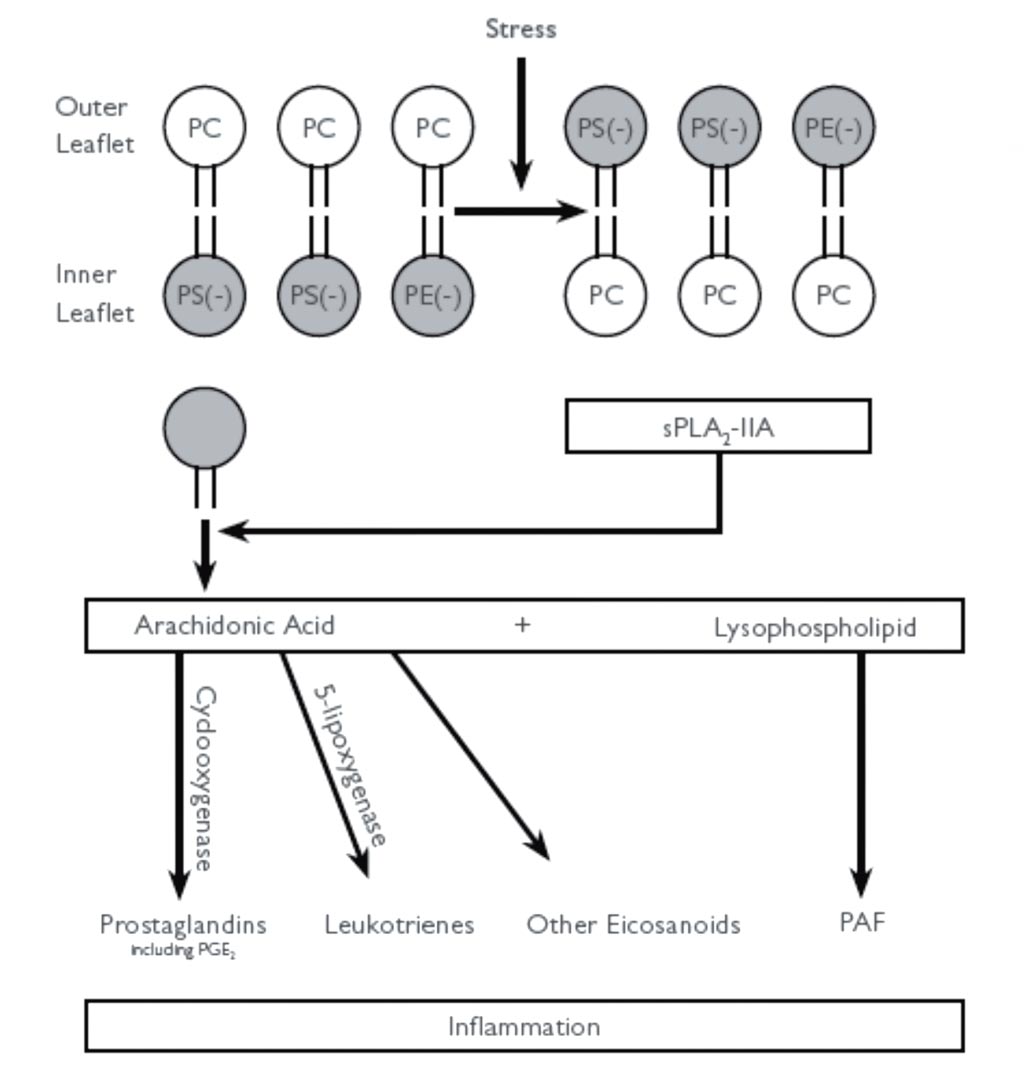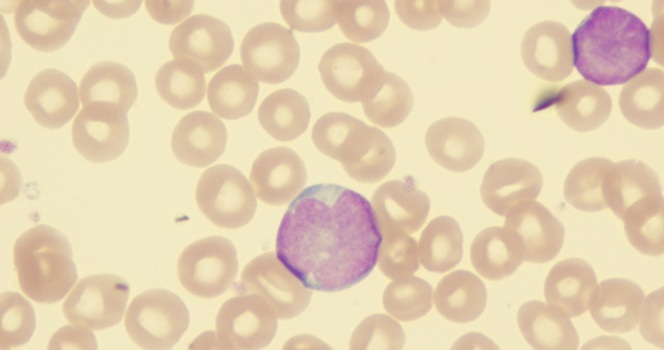New Automated Assay Measures Levels of sPLA2-IIA
|
By LabMedica International staff writers Posted on 08 Apr 2019 |

Image: The diagram shows how sPLA2-IIA binding to anionic phospholipids leads to its activation and promotes inflammation. The oxidation of the phospholipids produces stress, which causes the anionic phospholipids phosphatidylserine (PS) and phosphatidylethanolamine (PE) to be transported to the outer leaflet. This reaction activates cationic sPLA2-IIA. The higher activity of sPLA2-IIA promotes the hydrolysis of the outer leaflet phospholipids into arachidonic acid and lysophospholipids. Through the cyclooxygenase and 5-lipoxygenase enzymes, arachidonic acid is converted into prostaglandins, leukotrienes, and other inflammatory eicosanoids (Photo courtesy of Randox).
Phospholipase A2 (PLA2s) are a family of enzymes that cleave the fatty acid in position two of phospholipids, hydrolyzing the bond between the second fatty acid “tail” and the glycerol molecule. Of particular interest is the secreted phospholipase (sPLA2-IIA) that specifically recognizes the sn-2 acyl bond of phospholipids and catalytically hydrolyzes the bond, releasing arachidonic acid and lysophosphatidic acid. Upon downstream modification by cyclooxygenases, arachidonic acid is modified into active eicosanoid compounds, including prostaglandins and leukotrienes.
sPLA2-IIA has been shown to promote inflammation in mammals by catalyzing the first step of the arachidonic acid pathway by breaking down phospholipids, resulting in the formation of fatty acids including arachidonic acid. This arachidonic acid is then metabolized to form several inflammatory and thrombogenic molecules. Elevated levels of sPLA2-IIA are thought to contribute to several inflammatory diseases, and have been shown to promote vascular inflammation correlating with disease risk in coronary artery disease and acute coronary syndrome. Unlike traditional cardiac biomarkers used to predict adverse outcomes in patients, sPLA2-IIA has been shown to act at multiple pathways involved in atherogenesis, from lipid oxidation to modulation of vascular inflammatory cell activation and apoptosis. Measurement of sPLA2-IIA enables clinicians to gain a comprehensive overview of cardiac risk and may help to tailor treatment accordingly.
Recognizing the link between the secreted phospholipases and coronary disease risk, Randox (Crumlin, United Kingdom) has introduced an automated assay (currently for research use only) to measure levels of sPLA2-IIA. This automated assay eliminates the inconvenient and time consuming traditional ELISA based test for sPLA2-IIA.
The Randox sPLA2-IIA Assay was designed for use on a wide range of clinical chemistry analysers, and applications are available detailing instrument-specific settings. The latex enhanced immunoturbidimetric assay kit contains liquid ready-to-use reagents for convenience and ease-of-use. In addition, controls and calibrators are available offering a complete testing package. The addition of the sPLA2-IIA Assay compliments the existing cardiac risk panel from Randox, providing a different outlook and method of assessing cardiac concerns in patients.
sPLA2-IIA has been shown to promote inflammation in mammals by catalyzing the first step of the arachidonic acid pathway by breaking down phospholipids, resulting in the formation of fatty acids including arachidonic acid. This arachidonic acid is then metabolized to form several inflammatory and thrombogenic molecules. Elevated levels of sPLA2-IIA are thought to contribute to several inflammatory diseases, and have been shown to promote vascular inflammation correlating with disease risk in coronary artery disease and acute coronary syndrome. Unlike traditional cardiac biomarkers used to predict adverse outcomes in patients, sPLA2-IIA has been shown to act at multiple pathways involved in atherogenesis, from lipid oxidation to modulation of vascular inflammatory cell activation and apoptosis. Measurement of sPLA2-IIA enables clinicians to gain a comprehensive overview of cardiac risk and may help to tailor treatment accordingly.
Recognizing the link between the secreted phospholipases and coronary disease risk, Randox (Crumlin, United Kingdom) has introduced an automated assay (currently for research use only) to measure levels of sPLA2-IIA. This automated assay eliminates the inconvenient and time consuming traditional ELISA based test for sPLA2-IIA.
The Randox sPLA2-IIA Assay was designed for use on a wide range of clinical chemistry analysers, and applications are available detailing instrument-specific settings. The latex enhanced immunoturbidimetric assay kit contains liquid ready-to-use reagents for convenience and ease-of-use. In addition, controls and calibrators are available offering a complete testing package. The addition of the sPLA2-IIA Assay compliments the existing cardiac risk panel from Randox, providing a different outlook and method of assessing cardiac concerns in patients.
Latest Clinical Chem. News
- Chemical Imaging Probe Could Track and Treat Prostate Cancer
- Mismatch Between Two Common Kidney Function Tests Indicates Serious Health Problems
- VOCs Show Promise for Early Multi-Cancer Detection
- Portable Raman Spectroscopy Offers Cost-Effective Kidney Disease Diagnosis at POC
- Gold Nanoparticles to Improve Accuracy of Ovarian Cancer Diagnosis
- Simultaneous Cell Isolation Technology Improves Cancer Diagnostic Accuracy
- Simple Non-Invasive Hair-Based Test Could Speed ALS Diagnosis
- Paper Strip Saliva Test Detects Elevated Uric Acid Levels Without Blood Draws
- Prostate Cancer Markers Based on Chemical Make-Up of Calcifications to Speed Up Detection
- Breath Test Could Help Detect Blood Cancers
- ML-Powered Gas Sensors to Detect Pathogens and AMR at POC
- Saliva-Based Cancer Detection Technology Eliminates Need for Complex Sample Preparation
- Skin Swabs Could Detect Parkinson’s Years Before Symptoms Appear
- New Clinical Chemistry Analyzer Designed to Meet Growing Demands of Modern Labs

- New Reference Measurement Procedure Standardizes Nucleic Acid Amplification Test Results
- Pen-Like Tool Quickly and Non-Invasively Detects Opioids from Skin
Channels
Molecular Diagnostics
view channel
Simple Urine Test to Revolutionize Bladder Cancer Diagnosis and Treatment
Bladder cancer is one of the most common and deadly urological cancers and is marked by a high rate of recurrence. Diagnosis and follow-up still rely heavily on invasive cystoscopy or urine cytology, which... Read more
Blood Test to Enable Earlier and Simpler Detection of Liver Fibrosis
Persistent liver damage caused by alcohol misuse or viral infections can trigger liver fibrosis, a condition in which healthy tissue is gradually replaced by collagen fibers. Even after successful treatment... Read moreHematology
view channel
Platelet Activity Blood Test in Middle Age Could Identify Early Alzheimer’s Risk
Early detection of Alzheimer’s disease remains one of the biggest unmet needs in neurology, particularly because the biological changes underlying the disorder begin decades before memory symptoms appear.... Read more
Microvesicles Measurement Could Detect Vascular Injury in Sickle Cell Disease Patients
Assessing disease severity in sickle cell disease (SCD) remains challenging, especially when trying to predict hemolysis, vascular injury, and risk of complications such as vaso-occlusive crises.... Read more
ADLM’s New Coagulation Testing Guidance to Improve Care for Patients on Blood Thinners
Direct oral anticoagulants (DOACs) are one of the most common types of blood thinners. Patients take them to prevent a host of complications that could arise from blood clotting, including stroke, deep... Read moreImmunology
view channel
New Test Distinguishes Vaccine-Induced False Positives from Active HIV Infection
Since HIV was identified in 1983, more than 91 million people have contracted the virus, and over 44 million have died from related causes. Today, nearly 40 million individuals worldwide live with HIV-1,... Read more
Gene Signature Test Predicts Response to Key Breast Cancer Treatment
DK4/6 inhibitors paired with hormone therapy have become a cornerstone treatment for advanced HR+/HER2– breast cancer, slowing tumor growth by blocking key proteins that drive cell division.... Read more
Chip Captures Cancer Cells from Blood to Help Select Right Breast Cancer Treatment
Ductal carcinoma in situ (DCIS) accounts for about a quarter of all breast cancer cases and generally carries a good prognosis. This non-invasive form of the disease may or may not become life-threatening.... Read moreMicrobiology
view channel
Rapid Diagnostic Test Matches Gold Standard for Sepsis Detection
Sepsis kills 11 million people worldwide every year and generates massive healthcare costs. In the USA and Europe alone, sepsis accounts for USD 100 billion in annual hospitalization expenses.... Read moreRapid POC Tuberculosis Test Provides Results Within 15 Minutes
Tuberculosis remains one of the world’s deadliest infectious diseases, and reducing new cases depends on identifying individuals with latent infection before it progresses. Current diagnostic tools often... Read more
Rapid Assay Identifies Bloodstream Infection Pathogens Directly from Patient Samples
Bloodstream infections in sepsis progress quickly and demand rapid, precise diagnosis. Current blood-culture methods often take one to five days to identify the pathogen, leaving clinicians to treat blindly... Read morePathology
view channel
Tunable Cell-Sorting Device Holds Potential for Multiple Biomedical Applications
Isolating rare cancer cells from blood is essential for diagnosing metastasis and guiding treatment decisions, but remains technically challenging. Many existing techniques struggle to balance accuracy,... Read moreAI Tool Outperforms Doctors in Spotting Blood Cell Abnormalities
Diagnosing blood disorders depends on recognizing subtle abnormalities in cell size, shape, and structure, yet this process is slow, subjective, and requires years of expert training. Even specialists... Read moreTechnology
view channel
Artificial Intelligence Model Could Accelerate Rare Disease Diagnosis
Identifying which genetic variants actually cause disease remains one of the biggest challenges in genomic medicine. Each person carries tens of thousands of DNA changes, yet only a few meaningfully alter... Read more
AI Saliva Sensor Enables Early Detection of Head and Neck Cancer
Early detection of head and neck cancer remains difficult because the disease produces few or no symptoms in its earliest stages, and lesions often lie deep within the head or neck, where biopsy or endoscopy... Read moreIndustry
view channel
Abbott Acquires Cancer-Screening Company Exact Sciences
Abbott (Abbott Park, IL, USA) has entered into a definitive agreement to acquire Exact Sciences (Madison, WI, USA), enabling it to enter and lead in fast-growing cancer diagnostics segments.... Read more






















